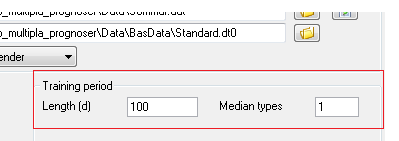
This is a model primarily intended to produce load or production forecasts for series that display a high degree of randomness, e.g. a series may contain random spikes that you want to prevent affecting the forecast. The model uses median values instead of mean values. The training period that Delphi uses is always immediately prior to the forecast start. Only data connected to this period is used. The model can either be made to attempt to model a day pattern or not. In the mode without a day pattern the model generates median values for the last 1, 2, 3, 6, 12, 24, 48, 96 and 168 hours and then examines which of these have given the best forecasts during the training period. Each forecast hour ahead in time is examined separately, so that if we want to determine the best median as forecast for hour 24 after the most recently received data, that median is selected which, during the training period, has resulted in forecasts with the least mean absolute error for precisely the hour in question. In the mode with day pattern, separate median values are also generated for each hour during the day, then the median for the day’s first hour is generated for the most recent 1, 2, 7, 14, 28, 60 days, the median for the second hour in the same way, etc. These are added to the usual medians, and the best median is selected from the full set of medians. Finally each hour is forecast based on “its” set of medians.
If the day type selection (2) in the image is set to something other than SingleType, the model will try to differentiate between weekdays and weekends, and create separate weekend medians and weekday medians as well as the usual medians.
The training period specifies how long an evaluation period is to be used. To be able to generate the various median types, large amounts of different data are required before the start of the training period. To be able to function at all, the following is required:
•A training period of at least 8 days plus a minimum of 16 days’ total data.
To be able to use day patterns, the following is required:
•A training period of at least 30 days plus more than 3 months’ total data.
To be able to use weekday/weekend separation, the following is required (depending on the split between weekends and weekdays):
•A training period of around 2 months plus more than 4 months’ data.
“Median types” control if the model is to try to work with day patterns. It must be 0 if no day pattern is in the load, otherwise it is set to 1. If it is 1, the training period should be increased to at least 30 days.
